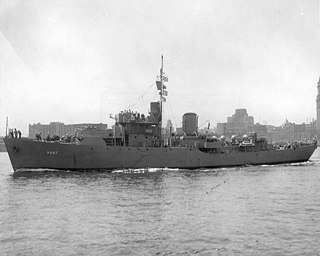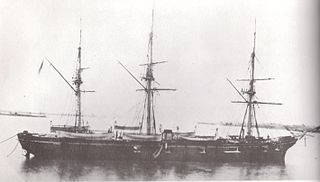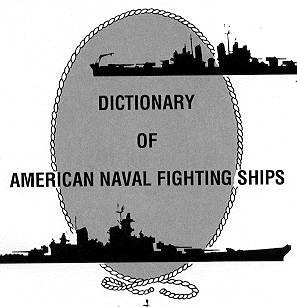
The second USS Sacramento (PG-19) was a gunboat in the United States Navy.

CSSVirginia II was a Confederate Navy steam-powered ironclad ram laid down in 1862 at the William Graves' shipyard in Richmond, Virginia. Acting Constructor William A. Graves, CSN, was the superintendent in charge of her construction. In order to conserve scarce iron plating, he ordered the ship's armored casemate shortened from the specifications given in John L. Porter's original building plans; in addition, the ship's iron-plating, while six inches thick on the casemate's forward face, was reduced to five inches on her port, starboard, and aft faces. Due to the shortening of her casemate, the number of her cannon were reduced to a single 11" smoothbore, a single 8" rifle, and two 6.4" rifles.

The Asiatic Squadron was a squadron of United States Navy warships stationed in East Asia during the latter half of the 19th century. It was created in 1868 when the East India Squadron was disbanded. Vessels of the squadron were primarily involved in matters relating to American commerce with China and Japan, though it participated in several conflicts over 34 years of service until becoming the Asiatic Fleet in 1902.

USS Southfield was a double-ended, sidewheel steam gunboat of the Union Navy during the American Civil War. She was sunk in action against the Confederate ironclad ram CSS Albemarle during the Battle of Plymouth (1864).

USS Cairo was one of the first American ironclad warships built at the beginning of the U.S. Civil War.

USS Ashuelot was an iron-hulled, double-ended, side-wheel Mohongo-class gunboat in the United States Navy. She was named for a river in New Hampshire.

USS Seneca was a Unadilla-class gunboat built on behalf of the United States Navy for service during the American Civil War. Seneca was outfitted with guns for horizontal fire as well as with two howitzers for bombardment of shore targets. With her crew of 84, she was assigned to the Union blockade of the Confederate States of America.

USS Kansas (1863) was a gunboat constructed for the Union Navy during the middle of the American Civil War. She was outfitted with heavy guns and assigned to the Union blockade of the waterways of the Confederate States of America. She was the first U.S. Navy ship to be named Kansas and was the first of a class of 836-ton screw steam gunboats, At war's end, she continued serving her country by performing survey work and defending American interests in Cuba until sold in 1883.

USS Williamsburg was a US Navy gunboat. A former private yacht, it also served as a presidential yacht from 1945 to 1953.

USS Unadilla was a Unadilla-class gunboat built for service with the United States Navy during the American Civil War. She was the lead ship in her class.

USS Alacrity (PG-87) was an Action-class patrol boat acquired by the United States Navy for the task of patrolling American coastal waters during World War II.
CSS Appomattox was a small propellor-driven steamer used early in the war by the Confederate Navy to defend the sounds of northeastern North Carolina. After participating in the battle for Roanoke Island it was burned to prevent capture on February 10, 1862, near Elizabeth City, North Carolina.

USS Ascutney (1862) was a large steamer with powerful guns acquired by the Union Navy during the American Civil War. She was used by the Union Navy as a gunboat in support of the Union Navy blockade of Confederate waterways. Post-war she performed some steamship service for the Navy.

USS Winooski (1863) was a large steamer with powerful guns acquired by the Navy at the end of the American Civil War. She was used by the Navy as a gunboat and served on the U.S. East Coast and the Caribbean Sea.
USS Glaucus was a large steamship acquired by the Union Navy during the American Civil War. The Union Navy planned to use her as a gunboat in the blockade of ports of the Confederate States of America, but, also found it useful to use her to transport the president of Colombia to Cartagena, Colombia.

USS Shawmut was a 593-ton steamer acquired by the U.S. Navy and put to use by the Union during the American Civil War.

The Battle of Havana on 9 November 1870 was a single ship action between the German gunboat Meteor and the French aviso Bouvet off the coast of Havana during the Franco-Prussian War.
CSS Forrest was a wooden-hulled Confederate gunboat that saw action in the North Carolina sounds in 1861 to 1862. Despite being considered "worn out", she saw continuous service until destroyed after the battle of Elizabeth City in February 1862.

The Unadilla class was a class of gunboat built for the Union Navy at the outbreak of the American Civil War. Ships of the class were also known as "90-day gunboats" due to their rapid construction. The class was designed to be fully oceangoing while having a light enough draft to be able to operate close inshore, for blockade duty or other operations in shallow waters.

The Erie class gunboats were a class of gunboats built by the United States prior to World War II. The class was designed in 1932, and commissioned into the United States Navy in 1936: Erie (PG-50) and Charleston (PG-51). The Eries had a design speed of 20 kn and a main armament of four 6-inch (152 mm) guns in single mounts with four 1.1-inch (28 mm) quadruple mount anti-aircraft guns.


















